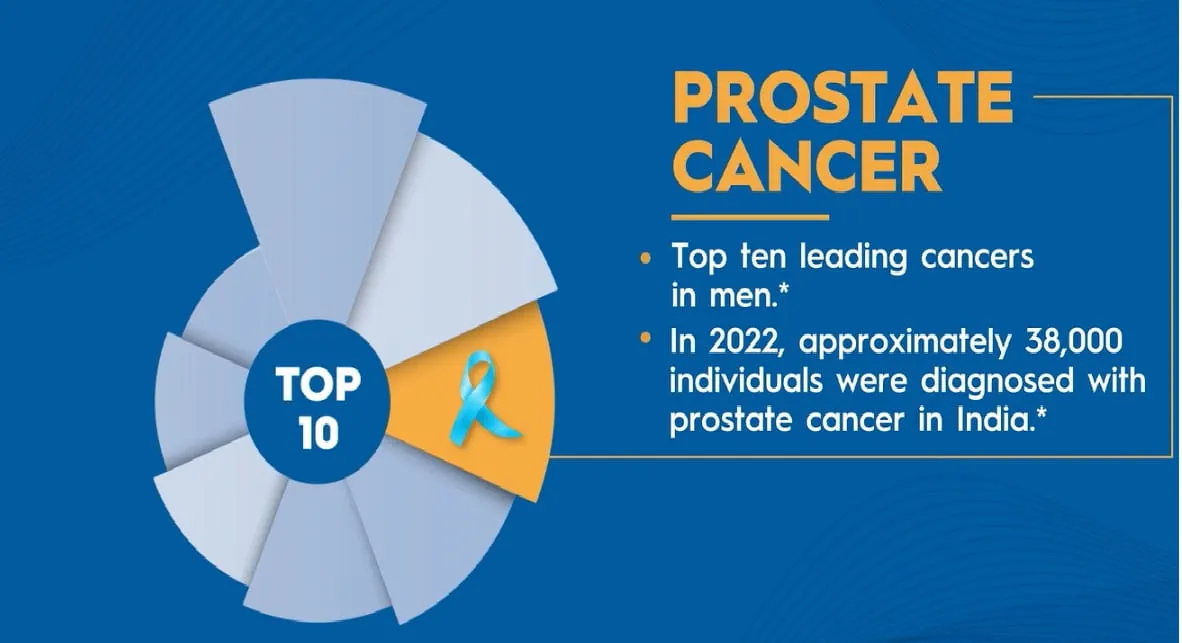Case presentation: A 50-year-old man asks for Prostate Cancer Early Detection by M. Maggi
A 49-year-old man visited a urology clinic in January 2024 to explore early detection of prostate cancer. His medical history indicated good health with no significant comorbidities, but his father had died of prostate cancer at 67. His PSA level was 4.3 ng/ml. A digital rectal exam (DRE) revealed a suspicious nodule in the right lobe, suggestive of cT2a disease. Following this, he underwent a multi-parametric MRI in February 2024, revealing a 30cc prostate gland with a PSA density of 0.16 and PI-RADS 3 lesions: a 7mm lesion in the right peripheral zone (Mid gland) and a 4mm lesion in the left peripheral zone (apex The management strategy for the patient included additional blood or urine tests, a neurologic visit in two years for follow-up, and a prostate biopsy.
MRI-led Prostate Cancer Screening-the UK Perspective by Professor Caroline Moore
In prostate cancer screening, traditional methods have shown a 20% decrease in mortality but lead to overdiagnosis and unnecessary procedures. The UK now employs MRI for men with a PSA level of 3 or higher, reducing low-grade cancer diagnoses to just 5%. However, higher age-adjusted mortality persists due to infrequent PSA testing. Black men in the UK face double the risk of diagnosis and death compared to white men. To address these issues, two UK trials aim to enhance prostate cancer screening. The first Prostogram trial, involving 411 men from 7 primary care practices across two centers, employed a blinded, paired, screen-positive design. Emphasizing ethnic diversity, 33% of participants were of black ethnicity, recruited through community approaches.
Screening tools included MRI, PSA (threshold of three), and ultrasound, with two thresholds for positive screening and biopsy. A PSA threshold of 3 resulted in a 10% biopsy rate, while using a PIRADS 3 threshold on MRI led to an 18% biopsy rate, suggesting a PIRADS 4 threshold to reduce biopsies to 10%. MRI sensitivity, particularly at thresholds of 4 or 5, outperformed PSA in detecting clinically significant prostate cancer. In a study at UCL, instead of using PSA thresholds, a PSA density threshold was combined with MRI screening to categorize men as either screened positive or negative. Men who tested positive for a high PSA density or a positive MRI underwent further NHS assessments, including multi-parametric MRI scans. The study compared outcomes between men with negative and positive prostate cancer screens. Those with clean MRI scans and low PSA density were referred to their GP, while those with high MRI signals were diagnosed with significant cancer. Challenges included lower response rates among black men. PSA density effectively identified potential cases with negative MRI results. Remarkably, many diagnosed men had PSA levels below three. MRI screening outperformed PSA density alone in detecting significant cancers. Overall, using MRI for screening could improve the identification of clinically significant cases, especially in men with low PSA levels, addressing disparities in screening response, particularly among black men.
PSA Only: PROBASE- the German Screening Trial in Young Men by BA. Hadaschik
PROBASE is a German prostate cancer screening study focusing on risk-adapted screening in young men. It involves randomizing men to start screening at age 45 or 50, following EAU guidelines. Screening frequency depends on baseline PSA values: PSA< 1.5 repeat testing every 5 years; PSA between 1.5-2.99 repeat testing every 2 years; PSA> three repeat PSA in two weeks then perform MRI and Biopsy. Results show that the screening process for PSA values > three at age 45 is deemed relatively ineffective due to its low cost-effectiveness, with only 0.8% of men exhibiting such elevated levels and a low prevalence of aggressive disease within this demographic. Among the 23,000 PSA tests conducted, there was a limited occurrence of grades > 3 for ISOP. However, as men age 50, there is a significant surge in the number of individuals with PSA values >3, indicating an increased risk. Notably, the inclusion of DRE at age 45 for those invited for screening at that age was found to be futile, potentially deterring men from seeking urological care. Moreover, the interpretation of MRI scans presents challenges, especially in younger men with small prostates and low PSA values, leading to discrepancies between local readers and experienced professionals. An excellent and known reader can yield a high negative predictive value (NPV) of 91%, reducing the need for biopsy. However, local reads often struggle with this accuracy. The speaker suggests that these challenges create opportunities for AI and new strategies to support MRI interpretation.
PSA + MRI (OPT - the Swedish screening strategy) by J. Hugosson
The Swedish-organized prostate cancer testing program (OPT) was launched in 2020 after the Swedish National Board of Health and Welfare recommendations and with government support. This program does not push for routine screening but instead informs men about the pros and cons of prostate cancer testing. If men choose to participate, the testing is free. The aim was to organize testing due to uncontrolled opportunistic testing rates and to increase knowledge and equality among men. The OPT involves PSA testing with a cutoff of three. Men with PSA levels above this cutoff undergo pre-biopsy MRI and further testing if necessary. A recent analysis of the OPT, published in European Neurology, focused on three major regions in Sweden. It involved 68,000 50-year-old men, of whom 35 % participated. There were significant regional differences in PSA levels and Gleason grading, highlighting a need for standardizing diagnostic pathways. There's a debate about whether MRI should replace PSA as the primary screening test. Arguments against widespread MRI use include resource limitations and concerns about increased overdiagnosis due to improved MRI technology detecting smaller tumors, including low-risk cancers. Lowering the PSA cutoff for MRI could detect more low-grade cancers but could also result in more overdiagnosis. Recent statistics from the National Prostate Cancer Register in Sweden show increased use of pre-biopsy MRI, which has reduced low-grade cancers (grade group 1) but increased the detection of grade group 2 cancers. This shift may reflect more accurate cancer grading due to MRI and targeted biopsies. In conclusion, the debate continues whether to use PSA or alternative biomarkers as the initial screening test to optimize MRI use and minimize the risk of overdiagnosing low-risk cancers. The optimal PSA cutoff for proceeding to MRI remains uncertain and requires further investigation.
PSA+ Risk Calculators + MRI (the EAU screening algorithm) by K. Beyer
The session highlights the ease and accessibility of Prostate-Specific Antigen (PSA) testing but underscores the importance of a step-by-step approach to avoid overdiagnosis and overtreatment. A risk-adapted strategy is advocated, which can reduce unnecessary procedures, improve the detection of clinically significant prostate cancer, and mitigate overdiagnosis. Although long-term outcomes are unavailable, lessons from traditional screening trials and ongoing research efforts, such as the PRAISE-U consortium, provide valuable insights. Three screening algorithms incorporating risk calculators are introduced, offering individualized assessments using PSA, DRE, Transrectal Ultrasound (TRUS), and sometimes MRI. While these approaches are non-invasive and user-friendly, they may pose cost and availability challenges, varying across countries.
Additionally, concerns about inter-rater reliability are acknowledged. The various pros and cons of different screening algorithms for prostate cancer are discussed. Improved sampling and reduced unnecessary MRIs are beneficial, particularly in algorithms like PI-RAD 3 scores. However, they note the issue of unnecessary biopsies in some cases and the challenge of still missing clinically significant prostate cancer in MRI-negative individuals, citing examples such as ProScreen and the STHLM-MRI data. Despite the benefits of risk stratification using MRI and biopsy, there are concerns about unnecessary MRIs, as seen in programs like OPT. Risk stratification tools and diagnostic methods, such as those employed in the PREISE-U consortium, are acknowledged for their efficiency in better sampling but are also noted as the most commonly used approach.
The variation in screening methods across different pilot sites, including PSA tests, DRE, and MRI, underscores the lack of a one-size-fits-all approach. Different countries utilize different risk stratification techniques, such as PSA density in Spain Manresa, compared to the ERSPC calculator used elsewhere. Additionally, multi-parametric and parametric MRI techniques are utilized across different sites. Incorporating additional risk stratification steps, often utilizing the E-R-S-P-C risk calculator, is a common practice. In conclusion, the evidence suggests a move towards a risk-based screening strategy, with the speaker advocating for using PSA testing, risk calculators, and MRI in combination. However, the choice of algorithm is contingent upon the capacity of the healthcare system in each country, and there is currently no universally applicable approach. Ongoing trials, like PRAISE U, are expected to provide further insight into the most effective screening algorithms.
PSA+MRI+Targeted Biopsies Only (Gothenburg-2 trial) by Hugosson
The Gothenburg 1 study initiated in 1995 invited 10,000 men for PSA testing every two years until 70, with systematic biopsies following elevated PSA levels. At age 70, 15% of invited men were diagnosed with prostate cancer compared to 7.4% in the control group. However, the incidence in the control group caught up over time, with an absolute difference of 4.7% at age 85. Overdiagnosis, attributed partly to non-attendance in the screening group and opportunistic screening in controls, presents a significant issue. The primary cause is systematic biopsies detecting small, slow-progressing tumors common in older men. To address this, the Gothenburg II trial proposes using MRI followed by targeted biopsies to avoid unnecessary biopsies while improving the detection and grading of larger cancers. The trial involves randomizing participants into different arms, with varying approaches to biopsy based on PSA levels and MRI results. The first report from this trial, based on the initial screening round, showed high participation and attendance rates for MRI and biopsy. The study compared two groups regarding PSA levels and biopsy indications. It found a significant reduction in biopsy indications in the experimental group, leading to a 54% decrease in clinically insignificant cancers (Gleason 3 plus 3) and a 19% decrease in higher-grade cancers. Systematic biopsies detected ten clinically significant cancers, all Gleason 3 plus 4, but were small and low-grade. The study suggests that using MRI-directed biopsies instead of systematic biopsies reduces overdiagnosis risk by half but may delay detecting intermediate-risk tumors in a few patients. The safety of delaying diagnosis for MRI-negative cases is questioned, particularly regarding the potential for missed curable cancers. Follow-up data, including repeated screenings, are being analyzed to address this concern, with initial findings expected to be published soon.
The Best and Most Pragmatic Way of Personalized Diagnosis of Prostate Cancer By C.H. Bangma
The session discusses the implementation of a screening program for prostate cancer in Europe, addressing the growing problem of a workforce gap in managing prostate cancer cases. It suggests involving general practitioners (GPs) in the screening process to alleviate the burden on specialists. The proposed approach involves GPs conducting initial assessments, including rectal examinations and PSA tests, followed by risk evaluation and referral to urologists for further diagnostic procedures if necessary. This collaborative model has shown promise in reducing unnecessary referrals and overdiagnosis while providing more accessible and personalized care for patients. The GPs may benefit from increased autonomy in decision-making with patients, though there could be a slight increase in workload due to expert information. Neurologists may see fewer patients but face a growing workload. Hospitals will likely have shorter waiting lists and use resources efficiently, satisfying governments' interests in early detection at low costs. However, determining the best approach is complex and influenced by European disease variability. Efforts, including those by the European Association of Urology (EAU), focus on early detection and outcome improvement using tools like PSA tests and imaging while minimizing overdiagnosis. Yet, what's technically optimal may not align with patients' needs for access, reduced anxiety, balanced information, and speed. The overview references studies like ERPC and PROTACS for context and highlights the significance of ongoing research. The session discusses the challenges and strategies in prostate cancer screening. Adherence to screening invitations remains low, with younger age groups showing particularly low yield.
Utilizing upfront selection criteria like PSAD and PSA isoforms may reduce reliance on expensive MRIs. Despite advancements, intermediate outcomes prevail, requiring further study. A combination of PSA screening and MRI with risk calculation is hoped to help health authorities prioritize longevity over cost. Prevention and early detection are advocated over costly late-stage treatments. Specificity improvement through calculators and targeted MRI is emphasized to reduce overdiagnosis. The availability of screening facilities across Europe is discussed, yet low compliance remains challenging.
In conclusion, balanced information dissemination facilitates informed decisions about early detection. The sustainability and efficiency of prostate cancer care are explored, including the role of commercial entities. Manpower shortages and waiting lists are potential barriers to early detection programs. Emphasizing first-line risk-based selection and personalized options, the speaker underscores the importance of efficient resource utilization.
European Association of Urology (EAU) Annual Congress 2024, 5th April - 8th April 2024, Paris, France




